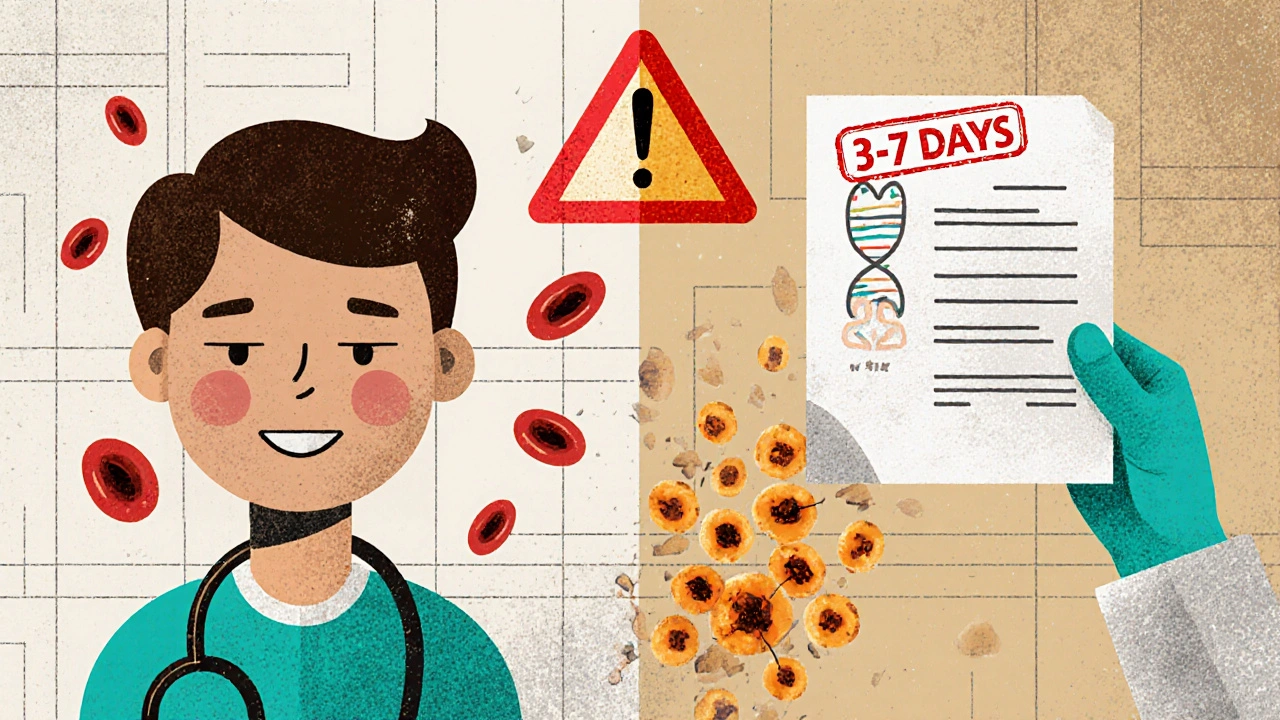Azathioprine and TPMT Testing: How Genetic Screening Prevents Life-Threatening Side Effects

Azathioprine Dose Calculator
How This Calculator Works
This calculator helps determine the appropriate azathioprine dosage based on your genetic test results. TPMT and NUDT15 testing identifies your body's ability to process azathioprine safely. Enter your body weight and test results to calculate your safe dose.
Enter your information to calculate your safe dose.
When you’re prescribed azathioprine for Crohn’s disease, lupus, or after an organ transplant, you’re not just getting a pill-you’re starting a treatment that could save your life. But for some people, that same pill can cause a dangerous drop in blood cells, leading to infections, bleeding, or even death. The difference between safety and disaster often comes down to a simple genetic test: TPMT testing.
Why Azathioprine Can Be Dangerous
Azathioprine has been used for over 60 years to calm overactive immune systems. It’s cheap, effective, and works well for long-term conditions like inflammatory bowel disease. But it’s also a drug that doesn’t play nice with everyone’s body. About 1 in 5 people who take it experience side effects-nausea, fatigue, liver issues, or worse. The most serious risk? Myelosuppression: your bone marrow stops making enough white blood cells, red blood cells, and platelets. Without enough white blood cells, even a cold can turn deadly.Here’s the catch: most doctors don’t know who’s at risk until it’s too late. That’s why TPMT testing exists. TPMT stands for thiopurine methyltransferase. It’s an enzyme in your liver that breaks down azathioprine. If your body makes too little of it, the drug builds up to toxic levels. And that’s not guesswork-it’s genetics.
What Is TPMT Testing, and How Does It Work?
TPMT testing looks at your genes to see how well your body can process azathioprine. There are two ways to do it: a blood test that measures enzyme activity (phenotyping) or a saliva or blood sample that checks for specific gene variants (genotyping). Genotyping is more common now because it’s not affected by recent blood transfusions or other drugs.The key variants are called *2, *3A, *3B, and *3C. If you have two copies of a non-working variant (homozygous), your TPMT activity is nearly zero. That’s rare-only about 0.3% of people, or 1 in 300, fall into this group. But for them, standard azathioprine doses can cause life-threatening pancytopenia within weeks.
More common-about 10% of people in the U.S.-are heterozygous. That means one working gene and one faulty one. Their TPMT activity is about half normal. These people can still take azathioprine, but they need a lower dose: 30% to 70% less than the usual 1.5-2.5 mg per kg of body weight. Start them at full dose, and their blood counts will crash.
It’s Not Just TPMT-NUDT15 Matters Too
For years, TPMT was the only gene doctors checked. But in 2019, the FDA updated the azathioprine label to include another gene: NUDT15. Why? Because in Asian populations-up to 20% of people in some groups-NUDT15 deficiency is the main reason for severe side effects, not TPMT.People with NUDT15 variants get the same toxic buildup as those with low TPMT. But if you’re of East Asian, Hispanic, or Native American descent and only test for TPMT, you could miss the real problem. That’s why leading guidelines from the Clinical Pharmacogenetics Implementation Consortium (CPIC) now recommend testing for both genes before starting azathioprine.
One patient I spoke with-Maria, 42, from Toronto-had normal TPMT results but developed severe neutropenia after two months on azathioprine. Her doctor ordered NUDT15 testing. She had a double variant. Her dose was cut in half, and her counts recovered. Without that second test, she might have kept taking the drug until her immune system collapsed.

What the Guidelines Say
The American Gastroenterological Association (AGA) says TPMT testing should be done before starting azathioprine. The European Crohn’s and Colitis Organisation (ECCO) calls it “recommended,” not mandatory. Why the difference? Cost and access.TPMT/NUDT15 testing costs $200-$400 in the U.S., with results in 3-7 days. Many insurers cover it, especially in academic centers. But in rural clinics or community practices, it’s often skipped because of delays or lack of awareness. The problem? The consequences of skipping it can be fatal.
CPIC guidelines are clear: if you’re homozygous deficient in TPMT or NUDT15, don’t use azathioprine at all. Switch to methotrexate or a biologic like adalimumab. If you’re heterozygous, start at 30-70% of the normal dose and check your blood counts weekly for the first month. After that, monthly checks are enough-if your counts stay stable.
Testing Isn’t a Magic Shield
Here’s the truth: TPMT and NUDT15 testing don’t prevent all side effects. About 1 in 10 people who take azathioprine still get liver damage, pancreatitis, or severe nausea-even with perfect genetic results. One patient in a 2000 JAMA Dermatology study had normal TPMT but developed liver failure. Another Reddit user wrote, “I had normal genes and still had to quit azathioprine. Testing isn’t foolproof.”That’s why labs and doctors still require regular blood tests. CBCs (complete blood counts) are non-negotiable. Liver enzymes need checking too. Azathioprine can also interact with drugs like allopurinol (used for gout), which blocks its breakdown and increases toxicity-no matter your genes. Even ACE inhibitors can raise the risk.
TPMT testing doesn’t replace monitoring. It just makes monitoring smarter. It tells you who needs a lower dose and who needs a completely different drug.
Cost vs. Risk: Is Testing Worth It?
Azathioprine costs $20-$50 a month. Biologics like infliximab cost $1,500-$2,500 per infusion. So why spend $400 on a test when the drug is so cheap?Because hospitalization for severe myelosuppression costs $15,000-$50,000. A single blood transfusion can run $2,000. A missed diagnosis can mean months in the hospital, missed work, or even death. In a 2011 trial of 333 patients, genotyping didn’t reduce overall side effects-but it did prevent catastrophic events in the one patient with homozygous deficiency.
That one patient was saved. And for every 300 people tested, you prevent one life-threatening event. That’s not just cost-effective-it’s lifesaving.

What You Should Do
If your doctor is about to prescribe azathioprine, ask these questions:- Have you checked my TPMT and NUDT15 status?
- If not, can we order the test before I start?
- What’s my dose going to be based on the results?
- Will I need weekly blood tests at first?
- Am I on any other meds that could interact, like allopurinol?
If you’re already on azathioprine and haven’t been tested, talk to your doctor. It’s not too late. And if you’ve had side effects before, testing now could explain why.
What About Sun Exposure?
One thing most patients don’t know: azathioprine makes your skin more sensitive to sunlight. You can get severe sunburns, rashes, or even skin cancer over time. Wear sunscreen daily, cover up outside, and avoid tanning beds. It’s a simple step-but one that could prevent years of skin damage.Final Thoughts
Azathioprine isn’t going away. It’s too useful, too affordable. But we’re past the point where we can treat it like a one-size-fits-all drug. Genetic testing for TPMT and NUDT15 isn’t futuristic-it’s standard care for anyone starting thiopurines. It’s not about over-testing. It’s about preventing avoidable harm.For the 0.3% of people with homozygous deficiency, it’s the difference between life and death. For the 10% with intermediate activity, it’s the difference between a manageable dose and a hospital bed. And for everyone else? It’s just good medicine.
Is TPMT testing required before taking azathioprine?
No, it’s not legally required, but major medical guidelines from the American Gastroenterological Association and CPIC strongly recommend it. Many hospitals and specialty clinics now make it standard practice. Skipping it increases the risk of severe side effects, especially in people with genetic variants that reduce drug breakdown.
Can I take azathioprine if my TPMT test shows low activity?
If you have severely low or absent TPMT activity (homozygous), you should not take azathioprine. The risk of life-threatening low blood counts is too high. Your doctor will switch you to another immunosuppressant like methotrexate or a biologic. If your activity is intermediate (heterozygous), you can take it-but at a reduced dose, usually 30-70% lower than normal, with close blood monitoring.
Does NUDT15 testing replace TPMT testing?
No. NUDT15 testing complements TPMT testing. In people of Asian descent, NUDT15 variants are a more common cause of toxicity than TPMT. That’s why current guidelines recommend testing for both genes together. Relying on just one test could miss a significant portion of at-risk patients.
How long does it take to get TPMT test results?
Most labs return results in 3 to 7 days. Some faster services may deliver in 48 hours. Because azathioprine can cause rapid drops in blood counts, doctors often delay starting the drug until results are back-especially if you’re at high risk or have other health conditions.
If I had a blood transfusion, can I still get accurate TPMT test results?
If you’re doing a phenotyping test (measuring enzyme activity in red blood cells), recent transfusions can give false results because you’re getting donor enzymes. Genotyping tests (DNA analysis) are not affected by transfusions since they look at your own genes. Always tell your doctor if you’ve had a blood transfusion in the last 3 months.
Can I stop azathioprine if I feel fine but my blood counts drop?
Yes. Even if you feel fine, a dropping white blood cell count is a red flag. Azathioprine can cause silent bone marrow suppression. If your CBC shows low counts and dose reduction doesn’t help, your doctor may recommend stopping the drug. Continuing could lead to serious infections or bleeding. Never ignore abnormal lab results.
Are there alternatives to azathioprine if I can’t take it?
Yes. Methotrexate is a common alternative, especially for people with TPMT or NUDT15 deficiency. Biologics like adalimumab, infliximab, or vedolizumab are also options, especially for inflammatory bowel disease. While more expensive, they don’t carry the same genetic risks. Your doctor will choose based on your condition, cost, and other health factors.
Does TPMT testing help prevent nausea or liver damage?
Not directly. TPMT testing mainly prevents myelosuppression-the dangerous drop in blood cells. Nausea is common and often dose-related but usually not genetic. Liver damage can happen regardless of TPMT status and is linked to another metabolite called 6-MMP. Regular liver function tests are still needed, even with normal TPMT results.